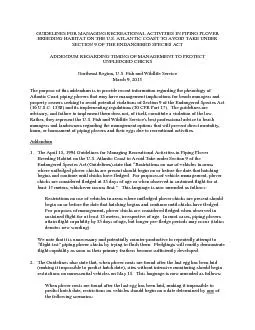/


OR MA NAGING RECREATIONAL ACTIVITIES I N PIPING PLOVER BREEDING HABITAT ON THE US ATLANTIC COAST TO AVOID TAKE UNDER SECTION 9 OF T HE ENDANGERED SPECIES ACT ADDENDUM REGARDING TIMING OF MANAGEME ID: 205217
Download Pdf The PPT/PDF document "GUIDELINES F" is the property of its rightful owner. Permission is granted to download and print the materials on this web site for personal, non-commercial use only, and to display it on your personal computer provided you do not modify the materials and that you retain all copyright notices contained in the materials. By downloading content from our website, you accept the terms of this agreement.
GUIDELINES F OR MA NAGING RECREATIONAL ACTIVITIES I N PIPING PLOVER BREEDING HABITAT ON THE U.S. ATLANTIC COAST TO AVOID TAKE UNDER SECTION 9 OF T HE ENDANGERED SPECIES ACT ADDENDUM REGARDING TIMING OF MANAGEMENT TO PROTECT UNFLEDGED CHICKS Northeast Region, U.S. Fish and Wildlife Service March 9 , 2015 The purpose of this addendum is to provide recent information regarding the phenology of Atlantic Coast piping plovers that may have management implications for beach managers and property owners seeking to avoid potential violations of Section 9 of the Endangered Species Act (16 U.S.C. 1538) and its implementing regulations (50 CFR Part 17 ). The guidelines are advisory, and failure to implement them does not, of itself, constitute a violation of the law. Rather, they represent the U.S. Fish and Wildlife Service's best professional advice to beach managers and landowners regarding the management options that will prevent direct mortality, harm, or harassment of piping plovers and their eggs due to recreational activities. Addendum 1. The April 15, 1994 Guidelines for Managing Recreational Activities in Piping Plover Breeding Habitat on the U.S. Atlantic Coast to Avoid Take under Section 9 of the Endangered Species Act (Guidelines) state that “Restrictions on use of vehicles in areas where unfledged plover chicks are present should begin on or before the date that hatching begins and continue until chicks have fledged. For purposes of vehicle mana gement, plover chicks are considered fledged at 35 days of age or when observed in sustained flight for at least 15 meters, whichever occurs first.” This language is now amended as follows: Restrictions on use of vehicles in areas where unfledged plover chicks are present should begin on or before the date that hatching begins and continue until chicks have fl edged. For purposes of management, plover chicks are considered fledged when observ ed in sustained flight for at least 15 meters , irrespective of age . In most cases, piping plovers attain flight capability by 35 days of age, but longer pre - fledge perio ds may occur (italics denotes new wording). We note that it is unnecessary and potent ially counter - productive to repeatedly attempt to “flight test” piping plover c hicks by trying to flush them . F ledgling s will readily demonstrate flight capability as soon as their primary feathers become sufficiently developed . 2. The Guidelines also state that, w hen plover nests are found a fter the last egg has been laid ( making it impossible to predict hatch date ) , sites without intensive monitoring should begin restrictions on nonessential vehicles on May 15. This language is now amended as f ollows: When plover nests are found after the last egg has been laid, making it impossible to predict hatch date, restrictions on vehicles should begin on a date determined by one of the following scenarios: 1) With intensive monitoring : If the nest is monitored at least twice per day, at dawn and dusk (before 0600 hrs and after 1900 hrs) by a qualified biologist, vehicle use may continue until hatching begins. Nests should be monitored at dawn and dusk to minimize the time that hatching may go undetect ed if it occurs after dark. Whenever possible, nests should be monitored from a distance with spotting scope or binoculars to minimize disturbance to incubating plovers. OR 2) Without intensive monitoring : Res trictions should begin on May 10 (the earliest probable hatch date). If the nest is discovered after May 10 , then restrictions should start immediately (italics denotes new wording) . Discussion The d ates and intervals associated with piping plover breeding cycle stages in the 1994 Gu idelines were formulated following an extensive review of the large volume of available breeding records. They were intended to furnish reliable advice to land managers seeking to avoid violations of the Endan gered Species Act without causing unnecessar y res trictions on beach recreation. R eview of monitoring reports routinely includes dates of piping plover arrival, nest initiation, hatching, and fledging. As of 2 010, the U.S. Fish and Wildlife Service (Service) was unaware of deviat ions in breeding phenology with implications for management. Since 2011 , however, the Service has receive d occasional reports of unusually delayed fledging periods , early hatch dates, and other phenological “ anomalies. ” Piping plovers older than 35 days that are incapable of flight have now been reported from several widely distributed sites in Massac husetts, New York, and Maryland. A few hatch dates prior to May 15 have been reported from New Jersey, Virginia , and North Carolina; given the overall synchrony of piping plover chronology across the U.S. Atlantic breeding range, we cannot rule out t he potential for early hatching anywhere from Maine to North Carolina. The Service has solicited information about potential contributing factors (e.g., evidence tha t prey is limited, harsh weather, unusual disturbance), but rare events are inherently difficult to interpret. To the best of our knowledge, t hese situations remain rare, but we continue to request reports of suc h instances and any potential causal factor s. At this time, t he Service is furnishing this information to help managers provide reliable expectations to the beach - going public.